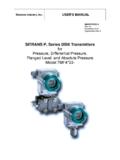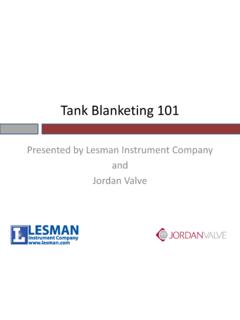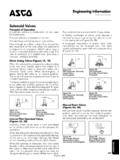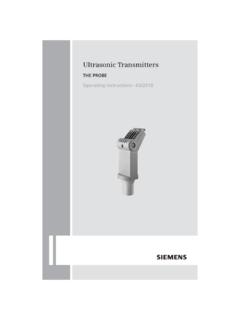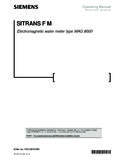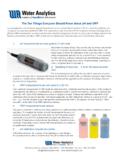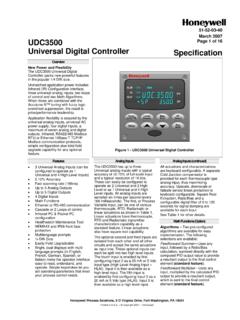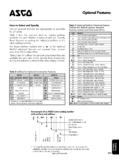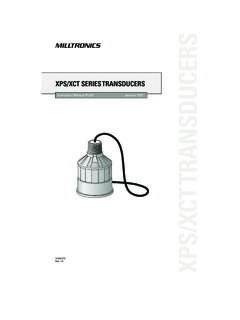Transcription of Intro to Air-Fuel Ratio Control - Lesman
1 Intro to Air-Fuel Ratio Control PiskorCombustion and Controls Overview Intro to Air/ fuel Ratio Combustion Terminology and Fundamentals Importance of Air/ fuel Ratio Control Methods of Air/ fuel Ratio Control Pros and Cons of Each Method Advanced Air/ fuel Ratio Control January 2015 Maintenance Dos and Don ts Adjustment Best Practices and Techniques Sample CalculationsCombustion Terminology Combustion The rapid oxidation of a fuel , usually via the oxygen present in air, resulting in the release of energy (heat and light). Combustion is the CONTROLLED rapid oxidation of a fuel . Explosion is the UNCONTROLLED rapid oxidation of a fuel . Stoichiometric Ratio The perfect amount of oxygen and fuel mixed during combustion such that nothing is left over. Example Reaction with Natural Gas (CH4): CH4 + 2O2+ 8N2 CO2+ 2H2O + 8N2+ heatCombustion Terminology (cont.)
2 Excess air / lean When more air (oxygen) is present than necessary to combust the fuel , resulting in left over oxygen. Most industrial combustion applications are run with excess air to ensure that there is no wasted fuel . Example: A Natural Gas burner which receives 15 parts air for every part fuel is running with 50% excess air. This burner can be described as running lean . CH4 + 3O2+ 12N2 CO2+ 2H2O+ O2+ 12N2+ heatCombustion Terminology (cont.) Excess fuel / rich When less air is present than necessary to combust the fuel , resulting in unburned fuel . Certain applications that require a long, luminous flame or need to Control the amount of oxygen within the combustion chamber would have burners set-up to run with excess fuel . Sometimes called sub-stoich since it s below the stoichiometric air-to- fuel Ratio .
3 2CH4 + 2O2+ 8N2 CH4 + CO2+ 2H2O + 8N2+ heatCombustion Fundamentals All fuels have a lower and upper flammability limit. Combustion can only occur between these limits. When changing the firing rate of a burner, both the air and fuel need to travel together to stay between these of GasLFLUFLS toichNatural Gas (CH4) (10:1) - Gas (C3H8) (25:1) - Gas (C4H10) (32:1) - Air/ fuel Ratio Control Prevent nuisance shut-downs Improper air/ fuel Ratio can cause the flame safeguard to lose the flame signal Improve fuel efficiency Improper air/ fuel Ratio can waste fuel Help obtain tighter Control for emissions driven applications Improper air/ fuel Ratio can increase NOx or CO production Help obtain better temperature Control Improper air/ fuel Ratio can make controlling temperature more difficultInspirators High pressure fuel is delivered to the inlet of the inspirator Venturi tube design pulls combustion air into the inspirator Ratio Control dictated by the size of the fuel nozzle and an air adjustment damperInspirators (cont.)
4 ~4:1 Turndown Pros: Low Cost, Simple Design, Available in many sizes Cons: Low turndown, Minimal characterization Critical Component: Gas Nozzle/SpudCross-Connected Ratio Regulators Composed of the following components: Air Control Device ( Control Valve or VFD) Proportionator/ Ratio Regulator Limiting Orifice Control signal sent to the air Control device, and an impulse line from air manifold feeds the fuel s Ratio regulator to adjust the fuel Ratio Regs (cont.) ~20:1 Turndown Pros: Flexible Installation, Low Cost Cons: Minimal characterization Critical component: Impulse LineMechanically-Linked Control Valves Air Valve and fuel Valve connected via mechanical linkage. Commonly found in boiler applications (jack-shaft) Characterizable fuel valves offer adjustment capabilities for the entire range of operation.
5 Good for multi- fuel and oil-fired Valves (cont.) ~40:1 Turndown Pros: Higher Turndown, More Characterization Cons: Higher Torque Requirements for Control Motors, Less Flexible Installation Critical Component: Linkage arm between air and fuel valvesElectronically-Linked Control Valves Sometimes referred to as Parallel Positioning System s Control interface receives single Control signal, and controls multiple actuators (can Control up to 4). Built-in safeties ensure that actuators travel together to maintain Ratio . Actuators are characterizable, allowing for individually defined flow curves. Commonly used in emissions driven applications due to repeatability of Control and level of characterization. Flexible to install since air and fuel valves do not need to be located near each Valves (cont.) ~40:1 Turndown Pros: Flexible Installation, Great Control Resolution Cons: Increased Complexity and Cost with Additional Components Critical Component: Control InterfaceFully Metered Mass Flow Control Air and fuel flow meters used in conjunction with electronically-linked Control valves.
6 Valve positions determined by central Control interface based on heat requirement and flow feedback. Commonly used in emissions driven applications due to repeatability of Control and level of characterization. Flexible to install since air and fuel valves do not need to be located near each Metered Mass Flow Control (cont.) ~20:1 Turndown Pros: Best Available Control Technology, Self-tuning/correcting with flow feedback Cons: More expensive, Can be slower to respond to aggressive Control signals. Critical Component: Interface Questions?

